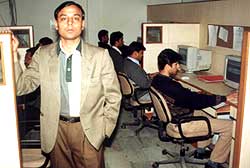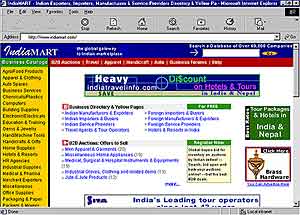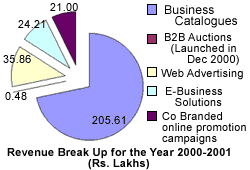e.com,
This is a story of a successful B2B portal that has grown with each passing year, last financial year was a boom time for Indiamart.com with a profit increase of 128%.
Ashok.K.Roy
Last few years belonged to the dotcoms. Every second idea that would spring up in business circles would relate to a net venture. Stories were in full circulation about how a smart idea after having put into reality on the internet made huge profits, while others saw venture capitalists (VCs) flock to them in huge numbers with bags of money ready to be pumped in. VCs who are basically pure business people willing to take high risk in the expectation of high returns, found the dotcom market to be highly lucrative. Coming back to the ideas that were becoming the talk of the town, they were getting recognition at a neck break speed, some of the entrepreneurs were smart enough to sell their brand and in return made a fortune out of the deal. But all were not that lucky. The bubble, which had overgrown its size had to burst, and when it finally did the casualties were numerous.
 The same trade pundits who had previously gone gaga over the potential of the dotcoms were eating their words and this time they were predicting that there can be no dotcom that can survive as an independent business. Well, its seems that these pundits had still not done their homework and were merely going about shooting their words without proper reasoning and substance. Today, as the storm is finally over, and dust having settled down, the actual scenario is now clear and the winers can be seen smiling. Although their smile may be prominent, their faces show signs of weariness. Today they feel better prepared to handle the future challenges as they are hardened who have also been enlightened.
The same trade pundits who had previously gone gaga over the potential of the dotcoms were eating their words and this time they were predicting that there can be no dotcom that can survive as an independent business. Well, its seems that these pundits had still not done their homework and were merely going about shooting their words without proper reasoning and substance. Today, as the storm is finally over, and dust having settled down, the actual scenario is now clear and the winers can be seen smiling. Although their smile may be prominent, their faces show signs of weariness. Today they feel better prepared to handle the future challenges as they are hardened who have also been enlightened.
For Dinesh Agarwal, the CEO of Indiamart, the venture was not just another website, it was his dream and future.
Having worked for companies like AT & T and Bank of America for more than six years and his stint of working in the US had surely given his entrepreneurial instincts a professional touch. Being a computer engineer himself, he was fully aware of the pitfalls of the business himself. Dinesh feels “the net still remains one of the greatest forces ever unleashed on man and there is nothing fundamentally wrong in using the net to deliver service.” He further adds, ” net, when used as the main business driver as a leverage can never fail if the business is conducted with sound financial management.” With his fundamentals in place, he got onto the task of establishing a multidisciplinary setup way back in April 1996, this was when the Internet was in its infancy in India. During this period Internet has barely touched India with 95% of Internet traffic concentrating in the US and Europe.
The model, which Dinesh felt could be a successful, if by any means he could provide a platform to the Indian Exporters looking for a global market and the international buyers looking for more options to buy their needs. This idea came to him by chance when he once received a query from one of his acquaintances in US who was looking for some Indian merchants who would be able to supply a specific requirement of Indian goods. This was enough to trigger his brain cells to get a project in order, which would be using the Internet as a bridge, he could not call it B2B because then the term was not even in circulation. His project was aimed in connecting businesses and providing a fast mode of communication. With this was born Indiamart the First Company in India to provide directory services for exporters and importers on the Net.
Initially, for Indiamart, the project was that of collecting the queries and forwarding the same to the merchants free of cost. It seemed to be a big boost for the SME (small & medium enterprise) who otherwise would never have even think of selling their goods globally on their own.
 The global platform or the e-hub helps the buyers and sellers to locate each other as per their requirements, interact, negotiate and conduct actual transactions online. The major chunk of the database was made available by ASSOCHAM, which had gone for a strategic tie-up with Indiamart. Today after having been in service for nearly five years the company has over 1100 business catalogues, of which there are 60,000 India related business under more than 450 product/service category. In total they have 70,000 listed businesses.
The global platform or the e-hub helps the buyers and sellers to locate each other as per their requirements, interact, negotiate and conduct actual transactions online. The major chunk of the database was made available by ASSOCHAM, which had gone for a strategic tie-up with Indiamart. Today after having been in service for nearly five years the company has over 1100 business catalogues, of which there are 60,000 India related business under more than 450 product/service category. In total they have 70,000 listed businesses.
The road to this stage was not an easy ride, in the words of Dinesh “We did not base our plan on any external funding possibilities, investments were made only after the cheques had come in as easy money was never taken and therefore capital wasn’t squandered. Infact, Dinesh was never interested in VC funding, coming form a background where the business was a way of life. His family business was trading in petroleum products. Since money was a hard earned, the expenditure was also kept on a tight leash. Infact, Dinesh goes on record saying that Indiamart did not send a penny on advertising, he believed that conservative promotion strategic was the right way in going bout rather than the much talked about theory of high voice being equivalent to high viewership leading to high business. One of the models, which suited Indiamart best, was getting the site maximum visibility on all major search engines.
Coming back to their main business that of online directories, as It was offering free listings, one would be forced to think that there is no revenue here. Yes, first glance one does get the impression but while having a closer look it can be seen that Indiamart encourages those listed under different sections to have a web presence of their own. Indiamart offers its expertise on site building for which it charges its merchants a fee. Those the service to Indiamart. The other source of revenue is from the registration that is done of the firms who are listed on the Indiamart site. Although most firms are listed free of cost but those who are registered are provided some exclusive services which a free listed firm will not be entitled to. The total revenue earned from these catalogues for the financial year 2000-2001 was Rs 205.61 lakhs which was also the major share of revenue earned by Indiamart.
 The next important revenue source is the B2B auctions, which was launched last year in December. In fact this addition of auctions on to the site has given Indiamart a opportunity to cash to the high visibility that it has earned for itself for the past few years. The Auction platform, which is the biggest in Asia, caters to over five lakh global B2B buyers that visit Indiamart every month. Here suppliers can register online and list their inventory for auction on an annual basis. The seller decides on the Reserve Price, Minimum bid price and bid increment amount. Interested buyers can bid on the items listed free of cost after going through the product information online. After the auction times out the seller is introduced to the winner to complete the transaction. The success of the B2B auction portal can be gauged from the fact form its introduction in Dec 2001 it has already earned through commissions Rs. 0.48 lakh for the last financial year.
The next important revenue source is the B2B auctions, which was launched last year in December. In fact this addition of auctions on to the site has given Indiamart a opportunity to cash to the high visibility that it has earned for itself for the past few years. The Auction platform, which is the biggest in Asia, caters to over five lakh global B2B buyers that visit Indiamart every month. Here suppliers can register online and list their inventory for auction on an annual basis. The seller decides on the Reserve Price, Minimum bid price and bid increment amount. Interested buyers can bid on the items listed free of cost after going through the product information online. After the auction times out the seller is introduced to the winner to complete the transaction. The success of the B2B auction portal can be gauged from the fact form its introduction in Dec 2001 it has already earned through commissions Rs. 0.48 lakh for the last financial year.
The other income streams for Indiamart are Web advertising which accounted for Rs 35.86 lakhs, e-business solutions worth Rs. 24.21 lakhs and co-branded online promotion campaigns for Rs 21 lakh. Speaking about the B2B auctions Dinesh says “Our strategy of network expansion to reach larger SME markets and offering multiple business services and solutions thereby generating multiple revenue streams has done the trick for us. We made it a point to run our business just like any other conventional business and not to get carried away by the media hype about dotcoms or the easy availability of VCs in the market. We only held the ground strongly and kept a close eye on our costs and revenues.”
The next step in auctions which Indiamart plans to unveil very shortly is the new B2B transaction platform aiming to offer facilities like B2B reverse auctioning, ETOs (Electronic Trade Offers), REQ/REP (Request for Quote/Request for proposal) along with business support services like business finance, logistics and insurance to facilitate online trade.
To facilitate proper functioning of the auction platform ensuring fair play by the participants and also ensuring the credibility of Indiamart, they tied up with SGS (Societe Generale de Survellance, Geneva). They are global verification giants in verification services.
Today as discussed earlier Indiamart has been making profits, according to the summary of financial results for the year ending 31st march 2001 shows a growth of 128% with revenue earned from its operations at Rs 287.16 lakh. The growth of Indiamart has been phenomenon with just one office in Delhi today it has branch offices in Mumbai, Chennai and Lucknow while its marketing offices are located across 24 cities. While its other global trade partners yourimporter.com a Dallas based online B2B auction platform and Indiafrance.com a France based enterprise gives Indiamart a much needed global foothold.
Dinesh Agarwal, CEO Indiamart.com speaks about his company and its future plans.
Amidst the failures in the dotcom, how come you are not only surviving, but also making profits?
Today we do feel satisfied looking back at the numerous failures and our survival. Yes, we were early starters much before the dotcom hype. Belonging to a trading family I was more interested in earning money, therefore our whole business model was to earn money and thereby create a portal, earn more money and create a stronger portal. We also made sure that only a percentage of revenues would be spent on making the portal. While all dotcoms were playing a valuation game with emphasis on eyeballs and expectations, infact there was a lot of money spent on advertising but they never had a credible business model. We believed that if had the Dotcom industry been treated as yet another traditional business the failure rate would have never been this high.
What was your idea behind starting Indiamart.com?
It was basically built to promote Indian Businesses abroad as internet had become a way of life and I felt there was scope for Indian businesses to spread globally via the Internet.
What was the core business that you had initially targeted for you business?
I was more interested in promoting the business of Indian suppliers: manufacturers, distributors, and exporters on the Net. We made Indiamart a business market place; creating business catalogs for companies, promoting their catalogs on various search engines.
What was your revenue model?
We went about developing business catalogues for Indian suppliers, we charge a fee of about Rs 5,000 per page of listing. After the initial listing, these companies pay an annual fee for the services. The second level was to go into a transaction based system where we would also be party to the transactions.
How much was your start-up money and what was your employee strength?
I had to invest family money as the startup capital, which included cost of space of around Rs five lakhs, plus around 40,000 as start up. Our company was put into working condition with the help of 20MB server space. Initially, our employee strength was just 3, which grew to 12 very soon. Now, there are 160 employees working with us.
What hurdles did you face while setting up your business?
Our major constraint right from unlike in the US where all Internet companies are based in small towns it was not possible for us to do so in India. The main reason was lack of quality manpower in smaller towns. I also wanted to make a very informative travel site but it was impossible to get information as there was no nodal agency to provide authentic information. Today I am proud to say that our travel portal has been recognised by many agencies and also been awarded for excellence.
How big or small was the Indian presence in the global trade market?
The Indian presence in the global trade market was very small and to make matters worse there is no nodal agency to provide facilities for small traders. In fact, export promotion agencies are hardly doing anything that would be directly bnefiting the supplier. There was significant scope for several companies such as ours to grow.
There was a huge hype about VC funding, but you seemed to stay away from it. What is the reason for that?
Yes, the temptation was always there, but we stayed clear because as VC money is considered to be easy money, people tend to spend it very easily. Although I feel that VCs have a greater role to play for established setups that have a successful model, this type of funding would give the venture a boost to improve its operations.
Your firm had an early mover advantage, but in the face of growing competition, how do you plan to stay ahead?
For the last one year I have come to know of a few people who have replicated our model but then I can proudly claim that we are much ahead in the race others have along way to go before they can actually catch up with us.
Do you have anything to say to a budding entrepreneur?
I would like them to keep a watch on the important trends such as the merging of technologies. As per the trends people are already speaking of the ultimate merger of telephone, the Internet and TV, secondly there is sufficient scope in interactivity on websites and information management, the most important thing here is to have a strong content and back-end support.
As the net population is quite sizeable now things are much better placed than it was 2-3 years ago so proper planning can surely prove beneficial in the long run.

